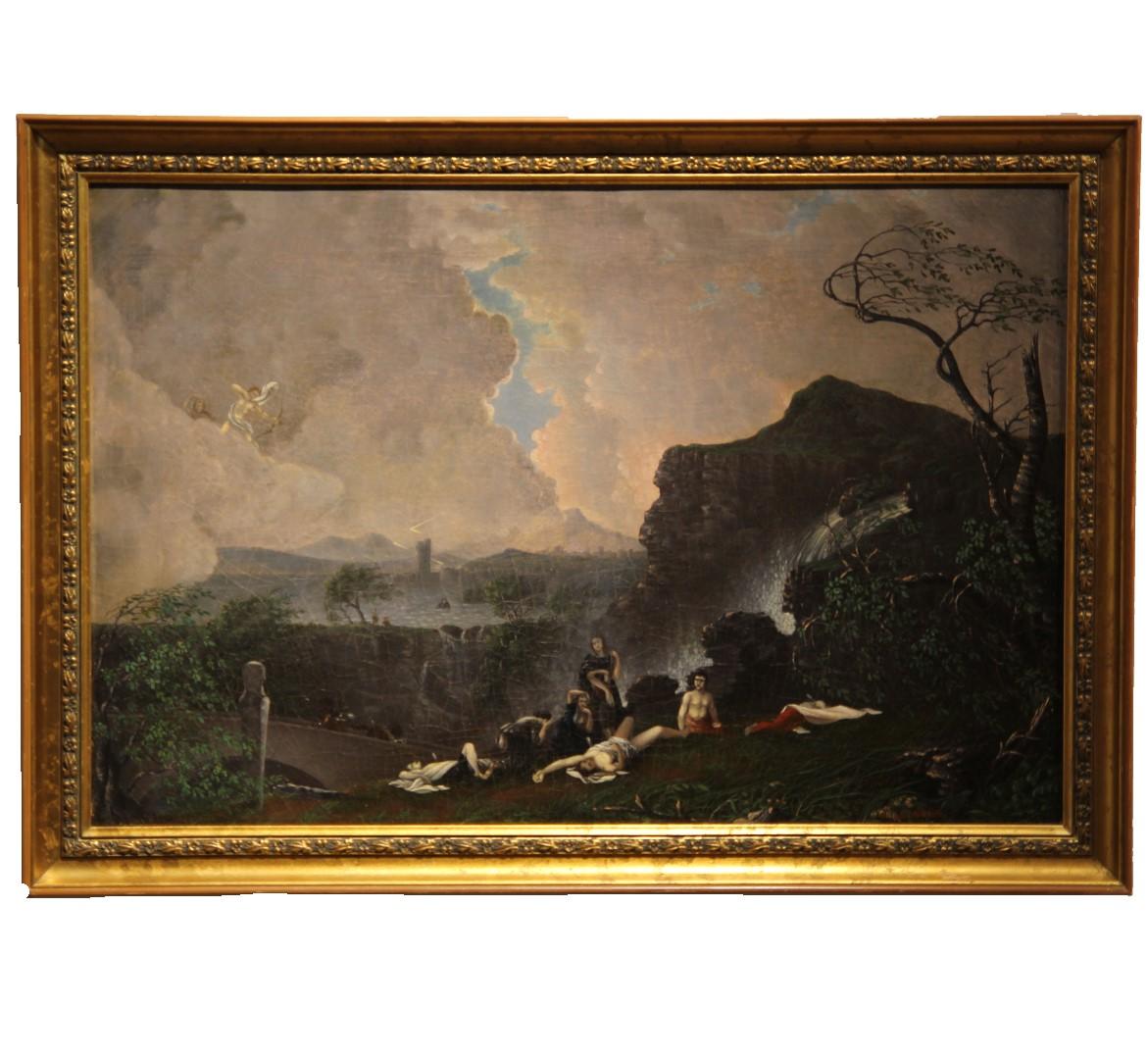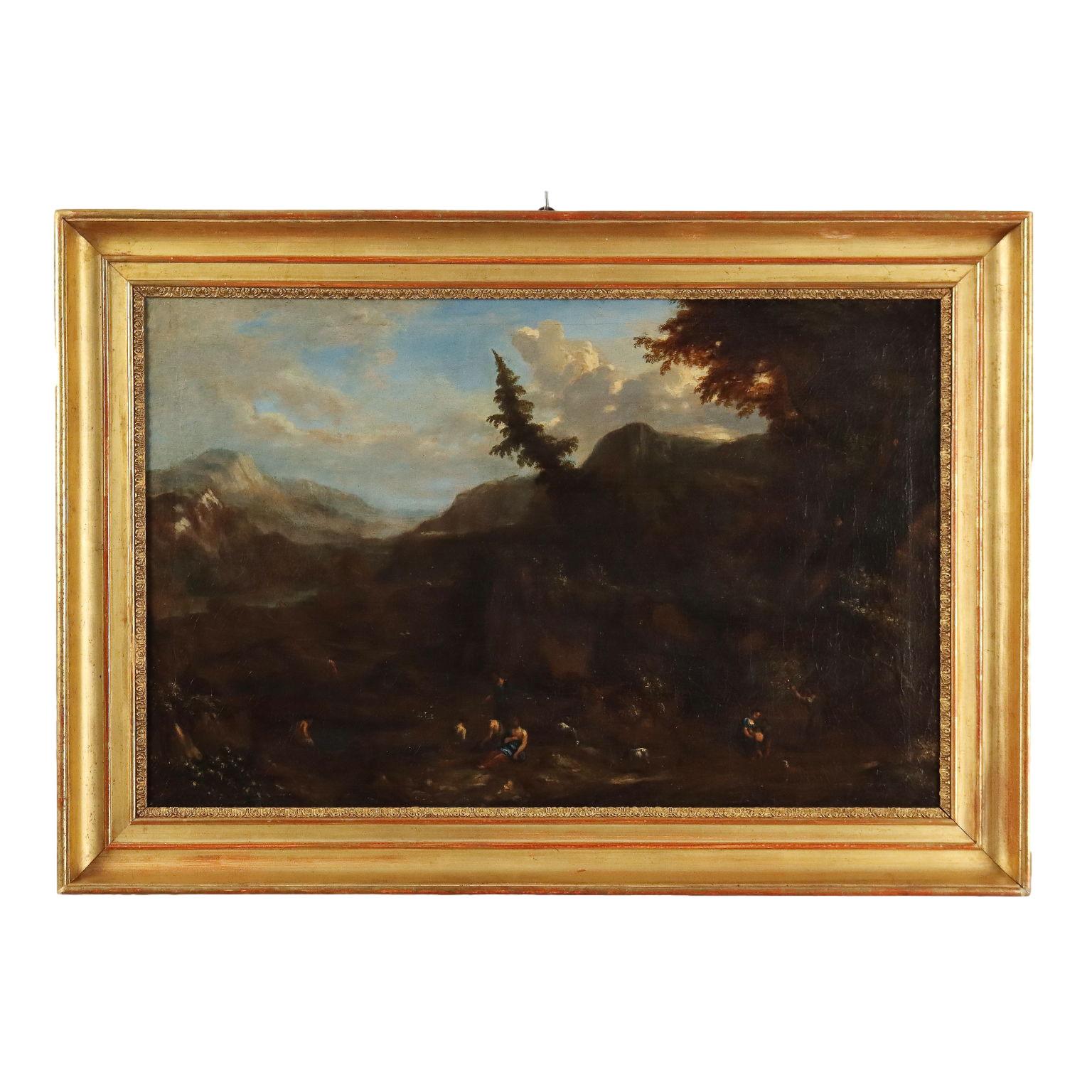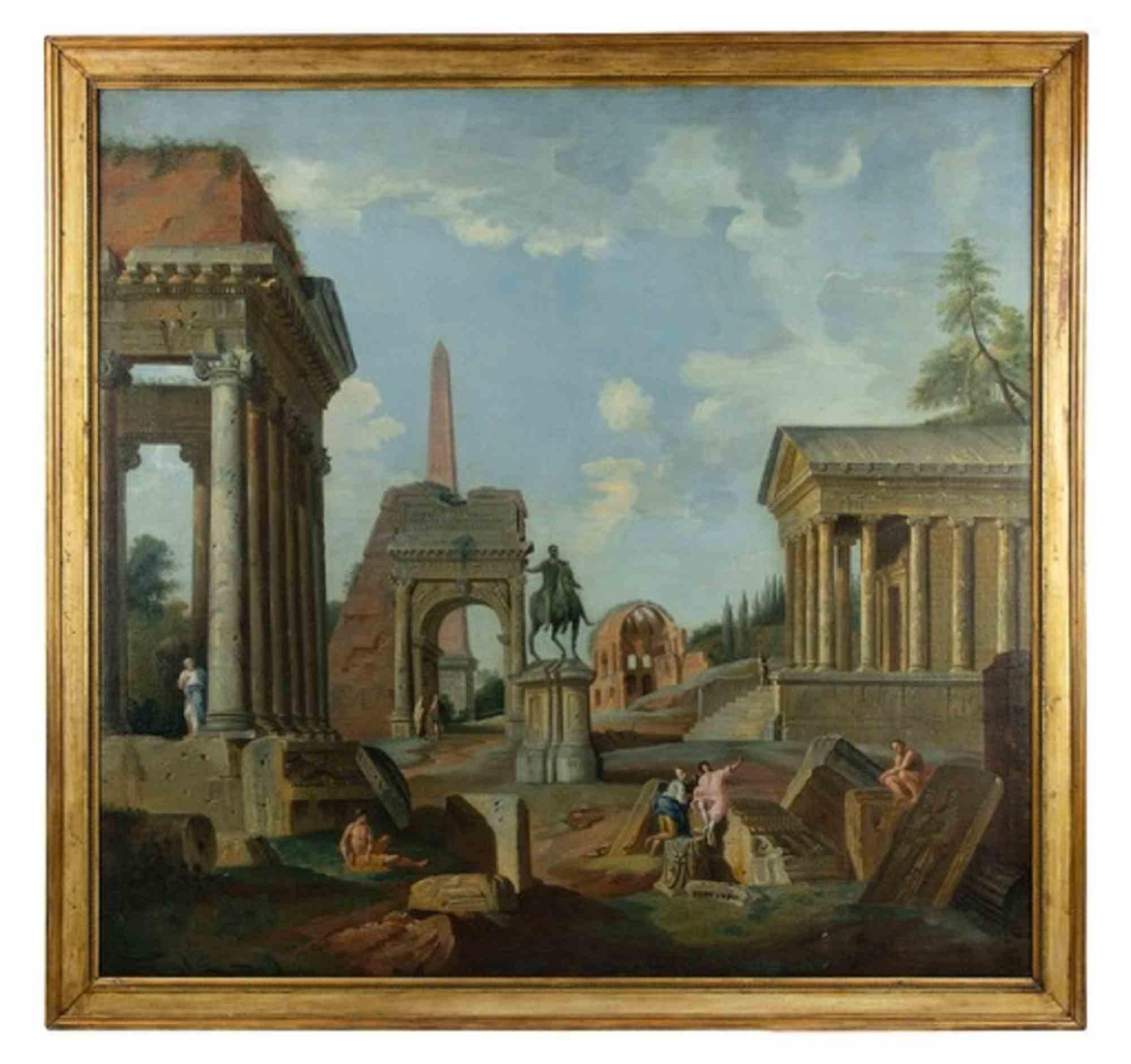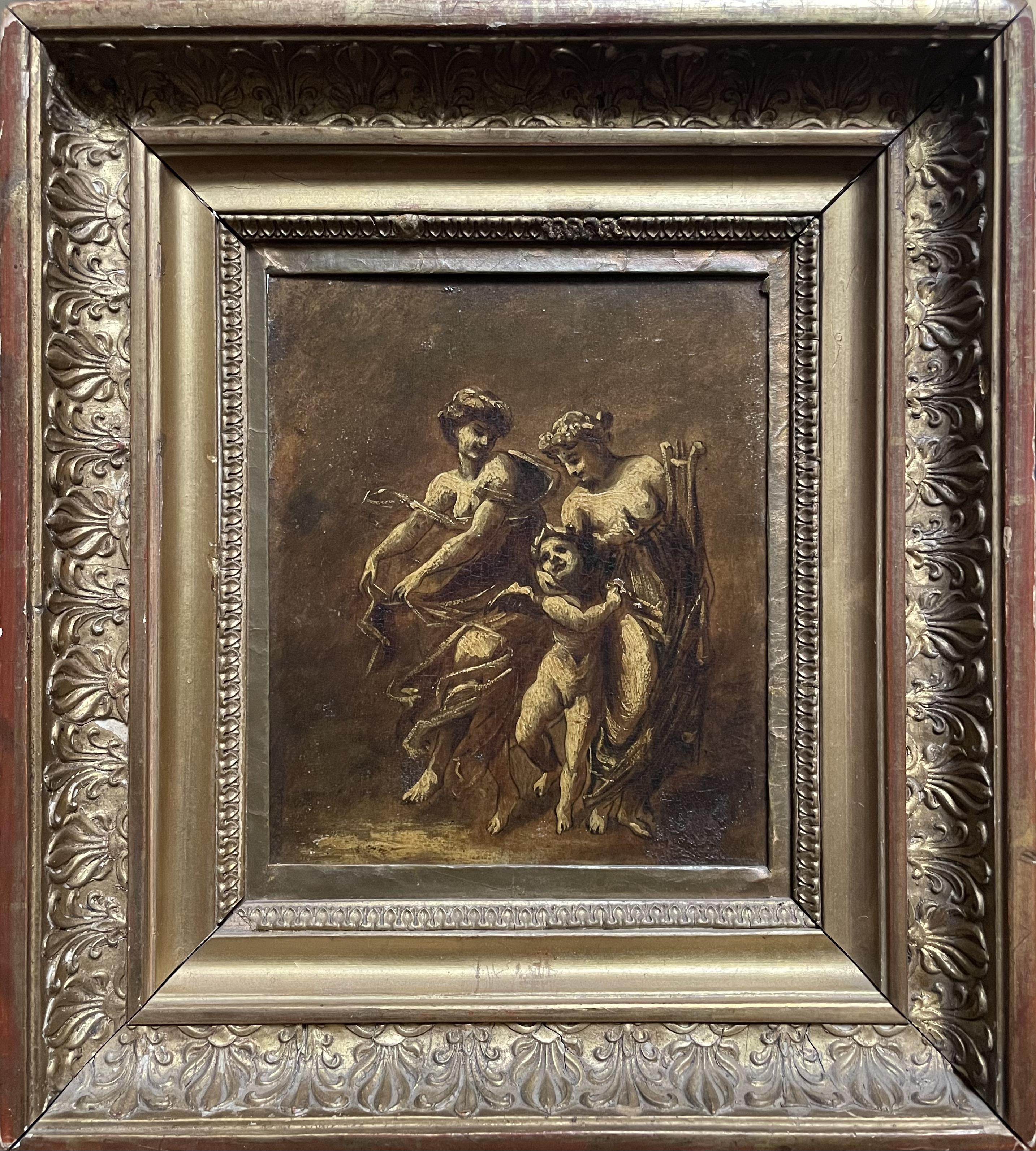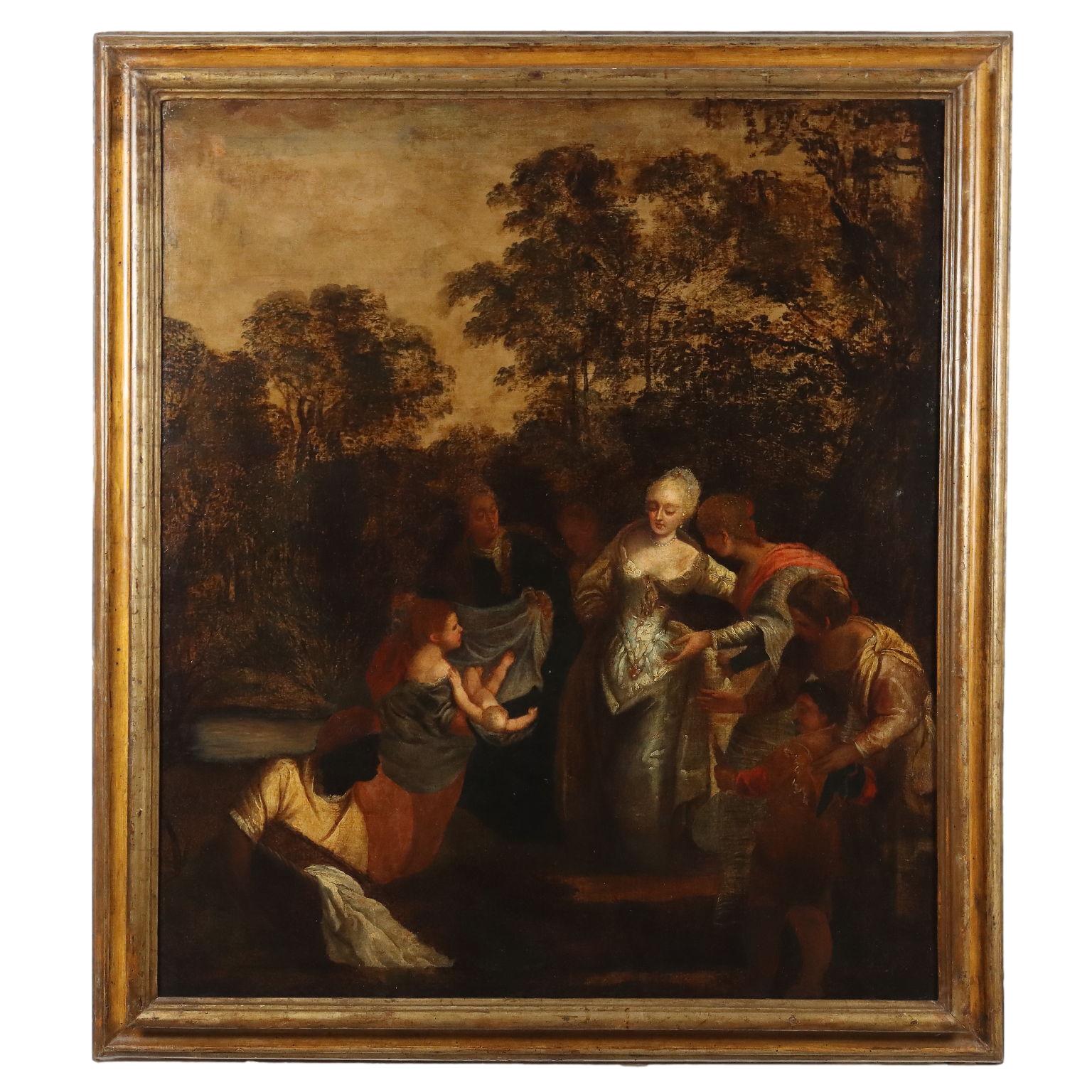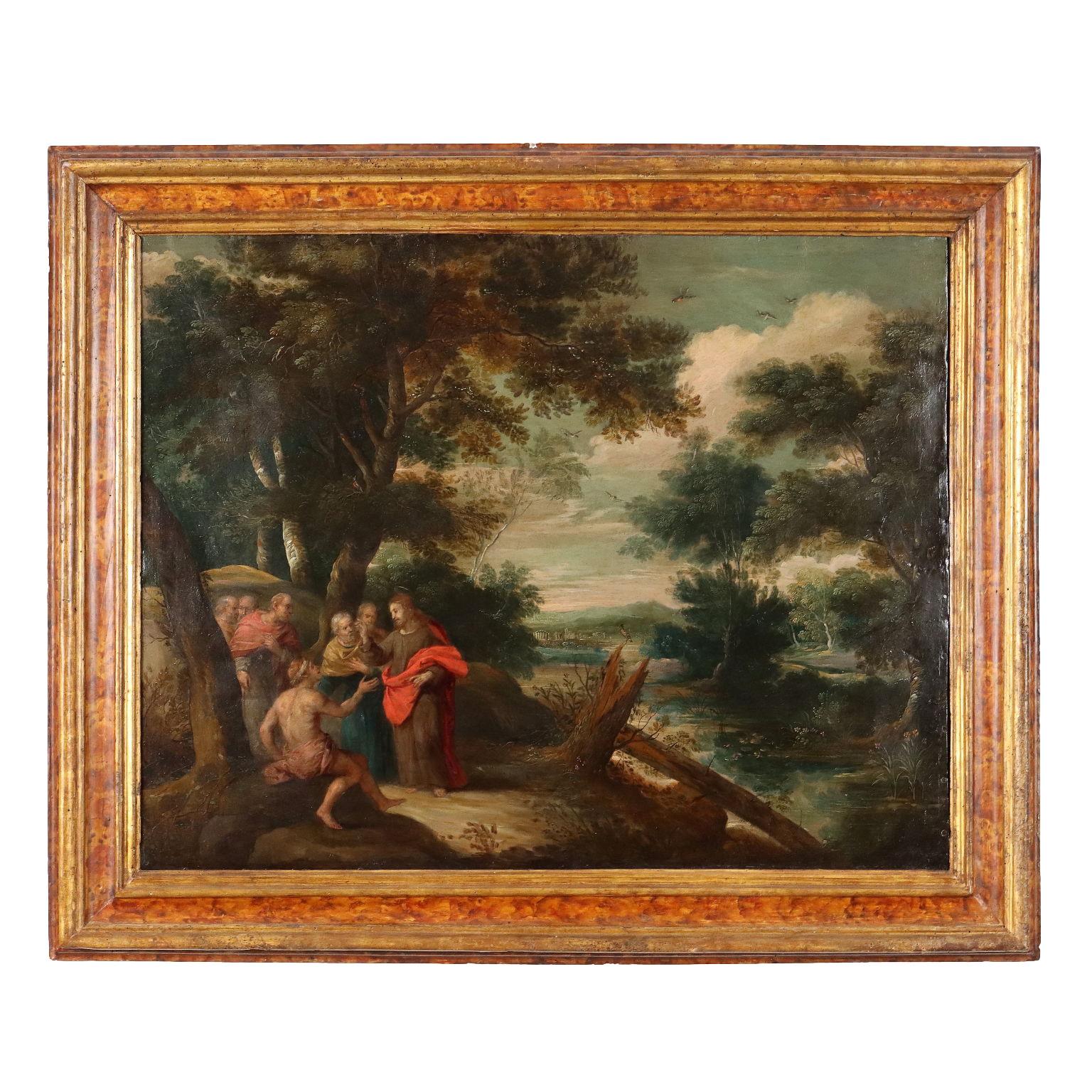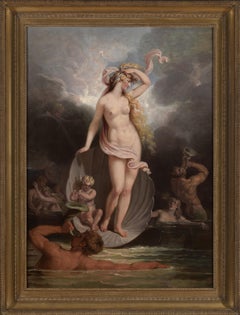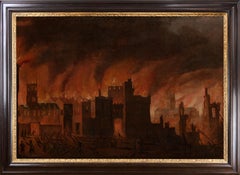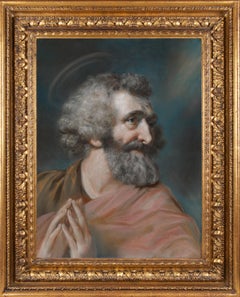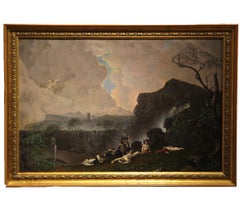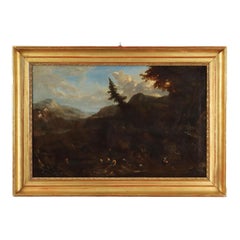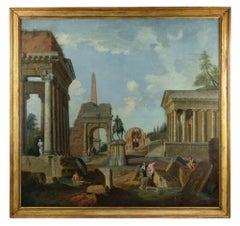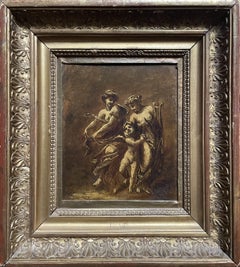Items Similar to 20th century oil painting entitled The Unknown Corner
Want more images or videos?
Request additional images or videos from the seller
1 of 8
James Pryde20th century oil painting entitled The Unknown Corner1912
1912
$20,547.06
£15,000
€17,676.56
CA$28,232.79
A$31,597.81
CHF 16,491.63
MX$385,330.36
NOK 211,070.37
SEK 199,805.14
DKK 131,917.79
Shipping
Retrieving quote...The 1stDibs Promise:
Authenticity Guarantee,
Money-Back Guarantee,
24-Hour Cancellation
About the Item
Collections:
Robert Isaacson;
James Draper, New York, 2014.
Exhibited:
Cambridge, The Fitzwilliam Museum, Beggarstaffs: William Nicholson and James Pryde, 2019, no. 57.
Framed dimensions: 23.50 x 19.50 inches
Pryde began his career as a graphic artist, working on advertising campaigns in partnership with William Nicholson. In 1893 Nicholson married Pryde’s sister, Mabel and the couple moved to an old inn, the Eight Bells, at Denham, Buckinghamshire. British poster design underwent significant changes in the 1890s. The old-fashioned bills with dense wording gave way to posters with a greater pictorial input, showing the influence of Toulouse-Lautrec and Japanese prints. In 1894 Pryde and Nicholson prepared several designs for an exhibition at the Westminster aquarium. Using paper cut-outs on rolls of brown paper their designs relied on striking, uncluttered silhouettes. They employed flat colours, strong outlines, and the spare use of lettering to create apparently easy yet memorable designs. They named themselves the Beggarstaff Brothers, the partnership lasted until 1899. Although it was never a financial success it had a profound influence on graphic art world-wide for many decades.
After the termination of his partnership with Nicholson, Pryde began to paint imaginative landscapes and architectural subjects. Often melancholic, they show a knowledge of the work of Velázquez as well as memories of the architecture of Edinburgh. The purchase of his Guildhall with Figures (1905) by J. S. Sargent was a landmark in Pryde's career, and from then on he exhibited regularly at the International Society, of which he eventually became vice-president, and at the Goupil Gallery.
His most important exhibited compositions belong to the series he called The Human Comedy, a title which consciously evokes that of Balzac’s famous series of novels (La Comédie humaine). The first in the series, The Doctor, introduces the motif of the four-poster bed: frequently identified as a bed at Holyroodhouse, associated in the early twentieth century with Mary Queen of Scots, it acted as the principal motif of the series. Whilst implying a narrative, Pryde never gave his pictures a specific text, instead relying on the drama of the composition itself to convey effect. Artistically, Pryde’s work is similar to his friends and contemporaries, particularly Glyn Philpot and William Orpen, both of whom were experimenting with grandly theatrical effects and a dark, old masterly palette around 1910.
The artistic sources for Pryde’s rich and evocative style are various. The use of an extremely course canvas, thickly applied paint and rich, dark palette suggest his interest in Spanish painting, particularly of Velazquez.
- Creator:James Pryde
- Creation Year:1912
- Dimensions:Height: 18.5 in (46.99 cm)Width: 14.5 in (36.83 cm)
- Medium:
- Movement & Style:
- Period:
- Condition:Preserved in good condition.
- Gallery Location:London, GB
- Reference Number:1stDibs: LU150727730152
About the Seller
5.0
Recognized Seller
These prestigious sellers are industry leaders and represent the highest echelon for item quality and design.
1stDibs seller since 2021
- ShippingRetrieving quote...Shipping from: London, United Kingdom
- Return Policy
Authenticity Guarantee
In the unlikely event there’s an issue with an item’s authenticity, contact us within 1 year for a full refund. DetailsMoney-Back Guarantee
If your item is not as described, is damaged in transit, or does not arrive, contact us within 7 days for a full refund. Details24-Hour Cancellation
You have a 24-hour grace period in which to reconsider your purchase, with no questions asked.Vetted Professional Sellers
Our world-class sellers must adhere to strict standards for service and quality, maintaining the integrity of our listings.Price-Match Guarantee
If you find that a seller listed the same item for a lower price elsewhere, we’ll match it.Trusted Global Delivery
Our best-in-class carrier network provides specialized shipping options worldwide, including custom delivery.More From This Seller
View All18th century oil sketches for a Baroque interior - a pair
Located in London, GB
A FEAST OF THE GODS WITH VENUS AND BACCHUS
Collections:
With Appleby Brothers, London, June 1957;
Hazlitt, Gooden & Fox, London, 1961;
John and Eileen Harris, acquired from the above, to 2015.
Literature:
Jacob Simon and Ellis Hillman, English Baroque Sketches: The Painted Interior in the Age of Thornhill, 1974, cat. no.12 (as by Louis Laguerre);
Elizabeth Einberg (ed.), Manners and Morals: Hogarth and British Painting, 1700-1760, exh. cat., London (Tate Gallery), 1987, cat. no.10 (as by Louis Laguerre);
Tabitha Barber and Tim Bachelor, British Baroque: Power and Illusion, exh. cat., London (Tate Britain), 2020.
Exhibited:
Twickenham, Marble Hill House, English Baroque Sketches: The Painted Interior in the Age of Thornhill, 1974, no.12 (as by Louis Laguerre);
London, Tate Gallery, Manners and Morals: Hogarth and British Painting, 1700-1760, 1987, no.10 (as by Louis Laguerre);
London, Tate Britain, British Baroque: Power and Illusion, cat. no 92, 2020.
CUPID AND PSYCHE BEFORE JUPITER
Collections:
With Appleby Brothers, London, June 1957;
Hazlitt, Gooden & Fox, London, 1961;
Anthony Hobson, acquired from the above, to 2015.
These recently re-united paintings are the most ambitious surviving baroque ceiling sketches made in Britain in the early eighteenth century. From the Restoration until the rise of Palladianism in the 1720s decorative history painting formed the preeminent artistic discipline in Britain. It was a field dominated by Continental artists including the Italian Antonio Verrio and the Frenchmen Louis Laguerre and Louis Chéron...
Category
Early 18th Century Baroque Figurative Paintings
Materials
Canvas, Oil
18th century allegorical painting of The Triumph of Beauty
Located in London, GB
Exhibited:
London, Royal Academy, 1800, no. 93
What was happening in British history painting in around 1800? In recent discussions of the emergence of a British School of history painting following the foundation of the Royal Academy in 1768, this is a question which is rarely posed and one which is not easily answered. Examination of surviving Royal Academy exhibition catalogues reveals a profusion of artists’ names and titles, few of which remain immediately recognizable, whilst endeavours to explain the impact of exhibition culture on painting - such as the 2001 Courtauld show Art on the Line - have tended to focus on the first and second generation of Royal Academician, rather than young or aspiring artists in the early nineteenth century. This makes the discovery and identification of the work under discussion of exceptional importance in making sense of currents in English painting around 1800. Executed by Edward Dayes...
Category
18th Century Old Masters Figurative Paintings
Materials
Canvas, Oil
Early oil depicting the Great Fire of London
Located in London, GB
The Great Fire of London in September 1666 was one of the greatest disasters in the city’s history. The City, with its wooden houses crowded together in narrow streets, was a natural fire risk, and predictions that London would burn down became a shocking reality. The fire began in a bakery in Pudding Lane, an area near the Thames teeming with warehouses and shops full of flammable materials, such as timber, oil, coal, pitch and turpentine. Inevitably the fire spread rapidly from this area into the City. Our painting depicts the impact of the fire on those who were caught in it and creates a very dramatic impression of what the fire was like. Closer inspection reveals a scene of chaos and panic with people running out of the gates. It shows Cripplegate in the north of the City, with St Giles without Cripplegate to its left, in flames (on the site of the present day Barbican). The painting probably represents the fire on the night of Tuesday 4 September, when four-fifths of the City was burning at once, including St Paul's Cathedral. Old St Paul’s can be seen to the right of the canvas, the medieval church with its thick stone walls, was considered a place of safety, but the building was covered in wooden scaffolding as it was in the midst of being restored by the then little known architect, Christopher Wren and caught fire. Our painting seems to depict a specific moment on the Tuesday night when the lead on St Paul’s caught fire and, as the diarist John Evelyn described: ‘the stones of Paul’s flew like grenades, the melting lead running down the streets in a stream and the very pavements glowing with the firey redness, so as no horse, nor man, was able to tread on them.’
Although the loss of life was minimal, some accounts record only sixteen perished, the magnitude of the property loss was shocking – some four hundred and thirty acres, about eighty per cent of the City proper was destroyed, including over thirteen thousand houses, eighty-nine churches, and fifty-two Guild Halls. Thousands were homeless and financially ruined. The Great Fire, and the subsequent fire of 1676, which destroyed over six hundred houses south of the Thames, changed the appearance of London forever. The one constructive outcome of the Great Fire was that the plague, which had devastated the population of London since 1665, diminished greatly, due to the mass death of the plague-carrying rats in the blaze.
The fire was widely reported in eyewitness accounts, newspapers, letters and diaries. Samuel Pepys recorded climbing the steeple of Barking Church from which he viewed the destroyed City: ‘the saddest sight of desolation that I ever saw.’ There was an official enquiry into the causes of the fire, petitions to the King and Lord Mayor to rebuild, new legislation and building Acts. Naturally, the fire became a dramatic and extremely popular subject for painters and engravers. A group of works relatively closely related to the present picture have been traditionally ascribed to Jan Griffier...
Category
17th Century Old Masters Landscape Paintings
Materials
Oil, Canvas
18th century portrait of the Royal Academy model George White
By John Russell
Located in London, GB
Collections:
Russell sale, Christie’s, 14 February, 1807: ‘John Russell, Esq., R.A. deceased, crayon painter to His Majesty, the Prince of Wales, and Duke of York; and brought from his late Dwelling in Newman Street’, lot 92, ‘St Peter’, bt. Thompson (£1.13s);
Anonymous sale; Sotheby's, London, 25th September 1980, lot 113;
Private collection, UK, 2016.
Literature:
Martin Postle, 'Patriarchs, prophets and paviours: Reynolds's images of old age', The Burlington Magazine, vol. cxxx, no. 1027, October 1988, pp. 739-40, fig. 9;
Martin Postle, Sir Joshua Reynolds: The Subject Pictures, Cambridge, 1995, p.136, repr.;
Neil Jeffares, Dictionary of pastellists before 1800, online edition, J.64.2928.
Signed and dated: J Russell/ fecit 1772 (lower right)
Framed dimensions: 25 x 31 inches
John Russell was admitted to the Royal Academy in March 1770, at the same time as Daniel Gardner. The nascent Academy Schools were still establishing their teaching structures, but central to the syllabus were the twin components of drawing after the antique and from life models. By 1772 Russell had already been awarded a silver medal and progressed to the life academy, where he produced this remarkable pastel study of George White. White was the most famous model employed by the Royal Academy and prominent artists in the second half of the eighteenth century. A paviour – or street mender –by profession White had been discovered by Joshua Reynolds, who in turn introduced him to the Academy. Russell’s striking head study demonstrates his abilities as a portraitist and pastellist, at the same time showing his interest in the Academy’s preoccupation with promoting history painting.
George White was one of the most celebrated models in eighteenth-century London. According to the painter Joseph Moser:
'Old George…owed the ease in which he passed his latter days, in a great measure to Sir Joshua Reynolds, who found him exerting himself in the laborious employment of thumping down stones in the street; and observing not only the grand and majestic traits of his countenance, but the dignity of his muscular figure, took him out of a situation to which his strength was by no means equal, clothed, fed, and had him, first as a model in his own painting room, then introduced him as a subject for the students of the Royal Academy.'
As Martin Postle has pointed out, whilst characterful studies of old men posed as biblical figures, prophets or saints by Continental old masters were readily available on the art market – Reynolds himself had copied a head of Joab by Federico Bencovich in the collection of his friend and patron, Lord Palmerston - finding a model in Britain from whom to execute a painting was more difficult.
White therefore offered a rare opportunity for artists to combine portraiture and history painting, by painting a model in the guise of an historical or literary character. In 1771 Reynolds showed at the Royal Academy a picture of White entitled Resignation. It was engraved in 1772 and accompanied by a stanza from Oliver Goldsmith’s Deserted Village, implying a literary context to what is essentially a portrait. In his annotated Royal Academy catalogue, Horace Walpole noted: ‘This was an old beggar, who had so fine a head that Sir Joshua chose him for the father in his picture from Dante, and painted him several times, as did others in imitation of Reynolds. There were even cameos and busts of him.’ White sat to, amongst others Johan Zoffany, John Sanders, Nathaniel Hone and the sculptor John Bacon...
Category
18th Century Old Masters Portrait Drawings and Watercolors
Materials
Pastel
Portraits of the Hon. Mary Shuttleworth and Anna Maria, 9th Baroness Forrester
By Daniel Gardner
Located in London, GB
THE HON. MARY SHUTTLEWORTH, NÉE COCKBURN (D. 1777)
and her sister
ANNA MARIA, 9TH BARONESS FORRESTER (D. 1808)
Pastel and gouache on paper laid on canvas, on their original backb...
Category
18th Century Old Masters Portrait Drawings and Watercolors
Materials
Pastel, Gouache
Eighteenth century Old Master drawing - St Jerome
By John Hamilton Mortimer
Located in London, GB
Pen, ink and wash
Framed dimensions: 9 ½ x 11 ¼ inches
Drawn c. 1763
This small, powerful study shows St Jerome contemplating the bible with a cross and sk...
Category
18th Century Old Masters Figurative Drawings and Watercolors
Materials
Ink, Pen
You May Also Like
Greek / Roman Naturalistic Allegory Painting
Located in Houston, TX
Stormy landscape scene in which a Cupid-like figure seen in the clouds appearing to have shot a number of wounded and dying men in the foreground. The men have a number of women and ...
Category
19th Century Academic Figurative Paintings
Materials
Oil
Landscape painting with figures, XVIIIth century
Located in Milan, IT
Oil painting on canvas. Central European school of the eighteenth century. Under a blue sky, a large, rather barren landscape is depicted, with the edge of a wood opening onto a rock...
Category
18th Century Other Art Style Landscape Paintings
Materials
Oil
Roman Ruins - Painting attr. to Francis Harding - 17th Century
Located in Roma, IT
Roman ruins is an original old master artwork realized realized by a follower of the artist Giovanni Paolo Panini and attributed to Francis Harding (1730-1766).
Mixed colored oil on canvas.
Includes frame.
The work is a replica of Panini's canvas made around 1740, made known by Ferdinando Arisi in his 1986 monograph (Cat.456) as belonging to the Galleria Taccani in Milan and recently reappeared on the London market...
Category
17th Century Modern Figurative Paintings
Materials
Paint, Oil
"Allegorical Scene with Mythological Figures"
Located in Edinburgh, GB
Unidentified Artist (19th Century)
"Allegorical Scene with Mythological Figures"
Materials & Condition
Medium: Oil on panel
Technique: Grisaille (monochrome painting)
Framed Dimensio...
Category
19th Century Figurative Paintings
Materials
Oil, Panel
Painting Moses Saved from the Waters 18th century
Located in Milan, IT
Oil on Canvas.
The painting looks to the similar work by Paolo Veronese (1528-1588), dated around 1560-70 and now in the Prado Museum, from which our painting takes up the compositio...
Category
18th Century Other Art Style Figurative Paintings
Materials
Oil
Painting with a Healing Scene 17th Century
Located in Milan, IT
Oil on copper. Flemish school of the seventeenth century.
The painting, attributed by oral tradition to Frans Francken the younger (1581 -1642), depicts a miraculous healing perform...
Category
17th Century Other Art Style Figurative Paintings
Materials
Oil
More Ways To Browse
The Antique Inn
Antique Bed Queen
Antique Call Bell
Poster Bed Used
Cambridge Poster
Edinburgh Poster
Mary Of Scots
Mary Queen Of Scots
Old Antique Bed Frames
William And Mary Antiques
Antique Spanish Bed
Antique Spanish Beds
Antique Four Poster Beds
J Roberts Antiques
Goupil Prints
Antique Japanese Bed
Queen Mary Poster
Antique Campaign Bed
